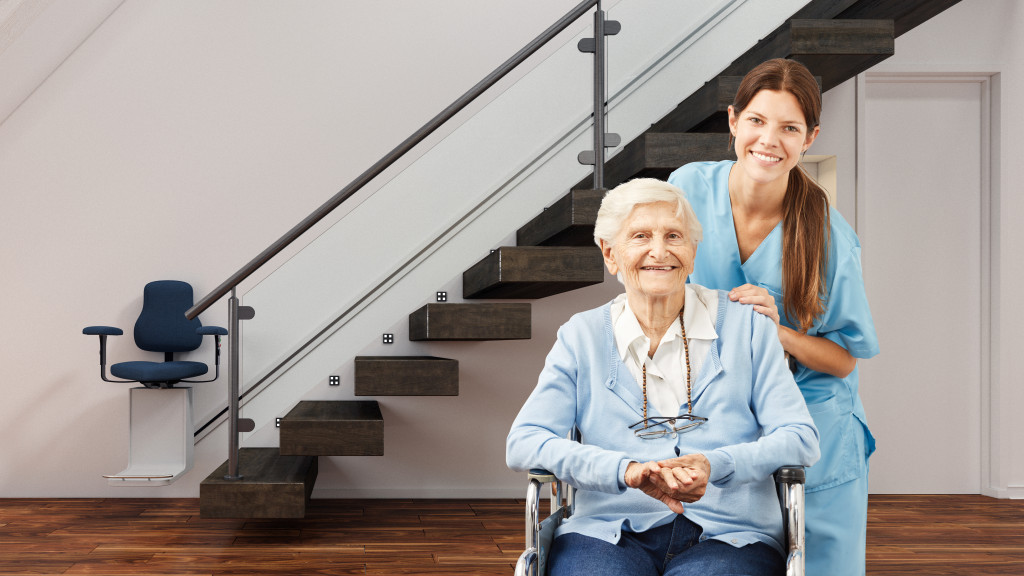- Installing grab bars, non-slip flooring, and ramps enhances safety and improves mobility within the home.
- Furniture, such as high-quality lift chairs, can improve comfort and facilitate movement.
- Maintaining a clutter-free environment minimizes tripping hazards and promotes ease of mobility.
- Upgrading to adjustable, task-specific lighting can prevent accidents and reduce eye strain.
- By implementing these changes, you can create a home that is safe, comfortable, and supportive of your well-being and independence.
As you age or face physical challenges, enhancing comfort at home becomes more than a luxury, it’s a necessity. Homes should be sanctuaries that promote wellness and aid mobility. This guide will provide practical solutions to transform your living spaces into comfortable, accessible environments. Get ready to experience a new level of wellness and freedom in your home.
Prioritize Accessibility
In creating an accessible home, it’s crucial to prioritize certain modifications that yield the highest comfort and efficiency. Read on to learn more.
Install Grab Bars

Grab bars are an essential home modification that significantly enhances accessibility and safety, particularly in areas like the bathroom. They provide solid support when transitioning from one position to another, such as getting in or out of the tub or standing from the toilet seat. Grab bars are sturdy, reliable, and designed to bear considerable weight, reducing the risk of falls and promoting independent mobility.
Their strategic placement in areas prone to slips and falls can transform the most hazardous spaces into safe, comfortable zones. Therefore, installing grab bars is a simple yet profoundly effective way to improve the accessibility and safety of your home.
Invest in Appropriate Furniture
Investing in appropriate furniture is a critical step toward enhancing home accessibility. Consider incorporating high-quality lift chairs into your living spaces. These specialized chairs are expertly designed with a powerful lifting mechanism that allows you to transition smoothly from a sitting to a standing position.
Beyond their practical function, high-quality lift chairs offer superior comfort, promoting relaxation and overall wellness. They often come with additional features such as heating, massage functions, and customizable positions for optimum comfort.
Moreover, they are available in various designs and materials, ensuring that they blend seamlessly with your home’s decor. Thus, high-quality lift chairs not only improve mobility but also contribute significantly to the aesthetic appeal of your home. By combining functionality with style, these chairs facilitate independence and enrich the quality of life, making them a valuable investment for a comfortable, accessible home.
Non-slip Flooring
Non-slip flooring is another important consideration for improving home safety and accessibility. These specialized floorings are designed with a higher coefficient of friction, reducing the likelihood of slips and falls, especially when the floor is wet. This feature is extremely beneficial in bathrooms and kitchens, where water spillage is common.
Non-slip flooring comes in various materials, including vinyl, rubber, and textured hard tiles, letting you choose based on your aesthetic preference and comfort. In addition to its practical advantages, the variety of designs and colors available allows it to enhance the visual appeal of your home. Therefore, by installing non-slip flooring, you can boost the safety, accessibility, and aesthetics of your home, creating an environment that is not only safe but also inviting and comfortable.
Install Ramps

Installing ramps is another effective modification you can make to increase accessibility in your home. Ramps make it easier for those using wheelchairs, walkers, or canes to move between different levels, both indoors and outdoors. They can be installed over existing stairs, making entrances more accessible.
Ramps can also help in other areas of the house, like transitioning from a garage into the home or navigating small steps. They come in various materials and styles, allowing you to choose one that fits your home’s aesthetics.
Moreover, ramps can be permanent or portable, offering flexibility based on your needs. The installation of ramps, consequently, contributes significantly to creating a comfortable and accessible living environment.
Clear Clutter
The importance of maintaining a clutter-free home cannot be overstated. Clutter not only encumbers mobility but can also become a potential tripping hazard, compromising safety within your house. Regularly organizing and tidying your living spaces can significantly enhance accessibility and comfort.
Prioritize clear walkways and easily accessible storage for everyday items. Utilize practical storage solutions like shelves, baskets, or hooks that allow items to be easily seen and reached, reducing the need for excessive bending or stretching.
Remember, a clean, well-organized home is conducive to not only physical safety and ease of mobility but also promotes a sense of peace and mental well-being. It creates a more inviting, serene environment, contributing to overall wellness. Therefore, decluttering is a straightforward yet highly effective strategy for pursuing a more comfortable, accessible home.
Upgrade Lighting
Adequate lighting is pivotal in creating a safe, accessible home environment. Effective lighting can prevent unnecessary accidents caused by poor visibility while also reducing strain on the eyes. Consider installing adjustable and ambient lighting fixtures in your home, which allow you to control light intensity based on your needs and the time of day.
Additionally, incorporate bright, direct lighting in task-specific areas such as the kitchen, study, or bathroom. Motion sensor lights can be particularly beneficial in hallways or entrances, providing hands-free illumination.
Remember to illuminate stairways and outdoor entrances adequately, as these areas pose a higher risk for falls. Furthermore, good lighting can enhance the aesthetics of your home, creating a warm, inviting atmosphere. Therefore, upgrading your home’s lighting is an essential step towards creating a comfortable, accessible, and aesthetically pleasing living space.
In conclusion, your home should be a safe, comfortable space that supports your well-being and independence. By implementing the suggestions outlined, you can transform your living environment into a sanctuary of accessibility and comfort. Start making these changes today and experience the profound difference it can make in your day-to-day life.






